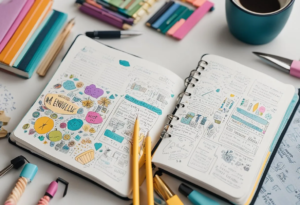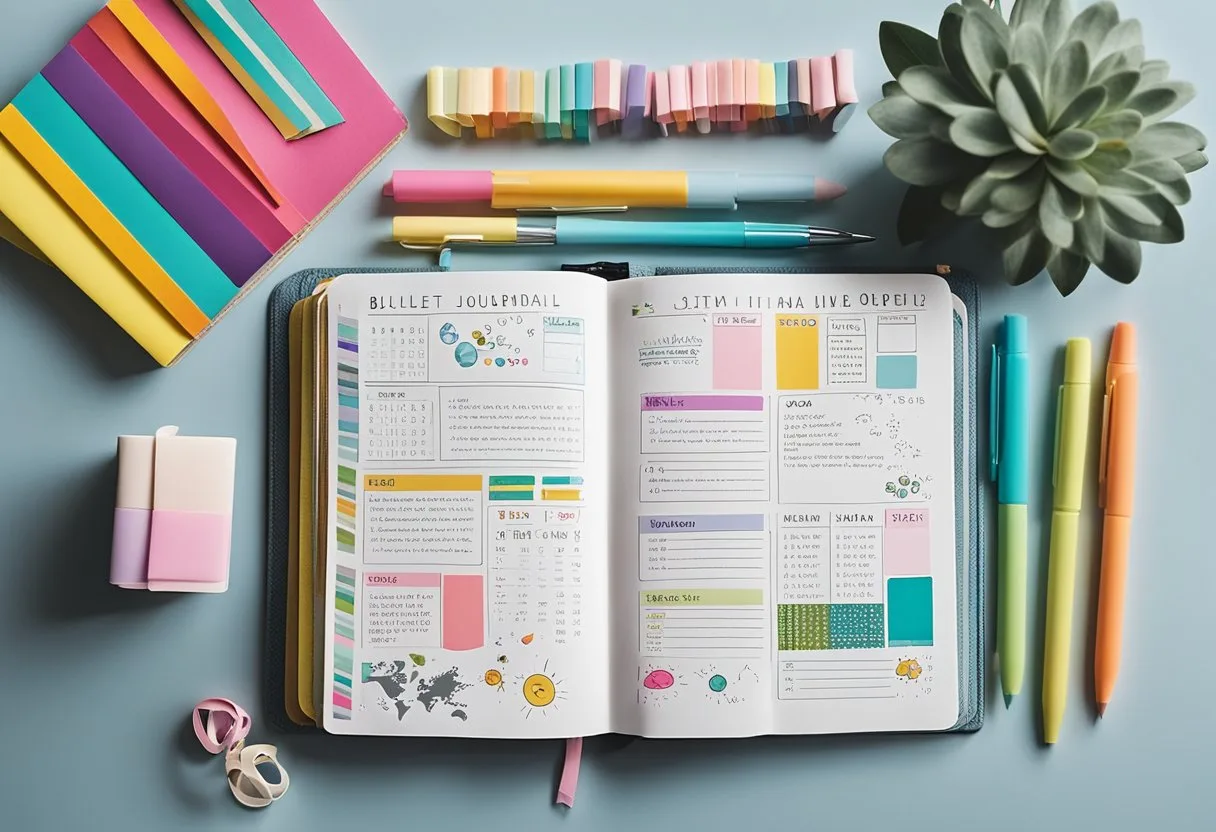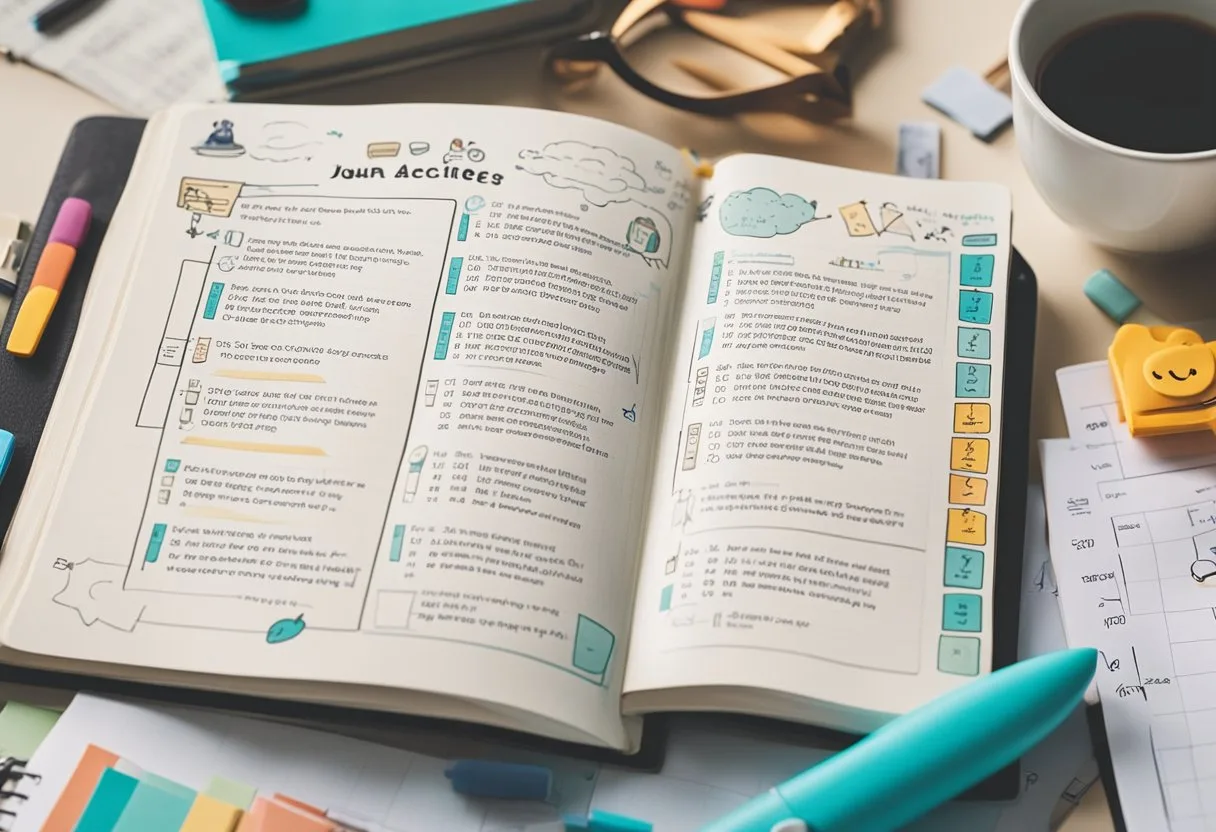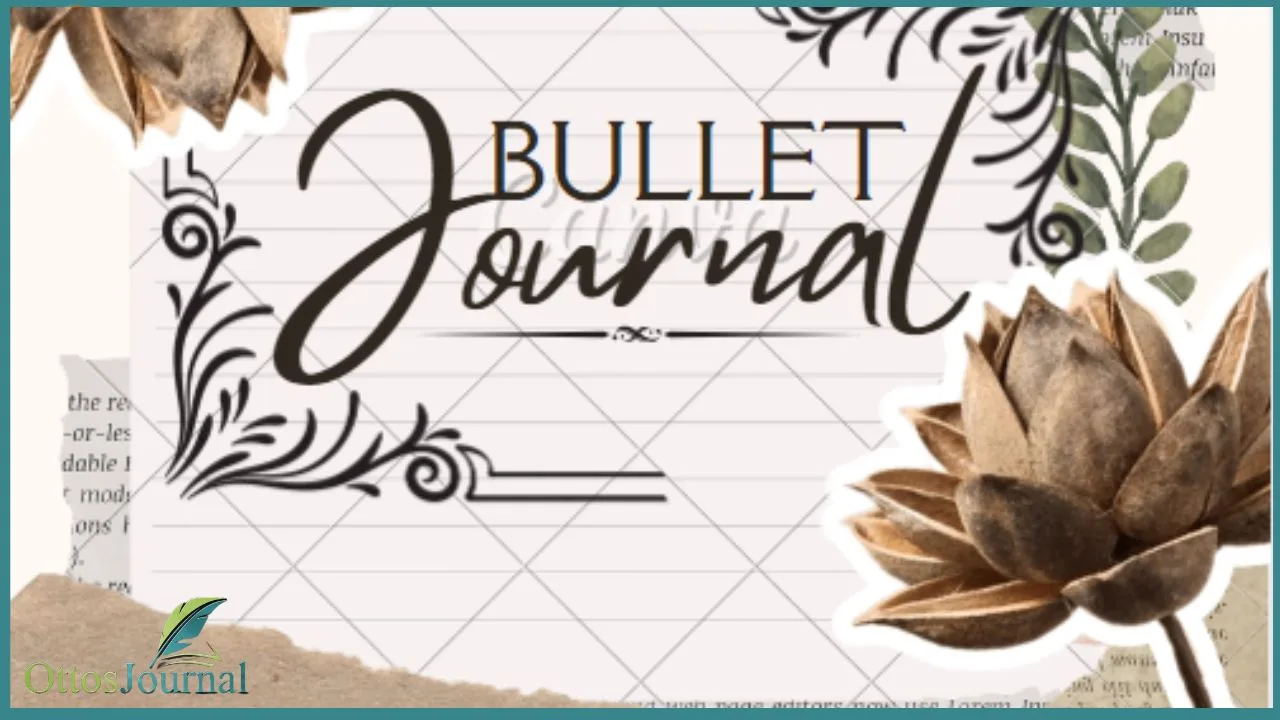A daily bullet journal is a popular organizational tool that has gained immense popularity in recent years. It is a system of journaling that helps people to keep track of their daily tasks, events, and appointments. The bullet journal system, also known as “bujo,” was created by Ryder Carroll and is designed to help people become more productive and organized.
Bullet journaling is a flexible system that can be adapted to suit individual needs and preferences. It can be used to track habits, set goals, plan projects, and much more. The system is based on the use of short-form sentences or “bullets” to record information, which makes it easy to scan and review the journal quickly. With the help of a daily bullet journal, people can stay on top of their tasks and make progress towards their goals.
Getting Started with Bullet Journaling
Bullet journaling is a simple and effective way to organize your daily tasks, events, and thoughts. It is a versatile system that can be customized to suit your unique needs and preferences. Here are some tips on how to get started with bullet journaling.
Choosing Your Bullet Journal
The first step in starting your bullet journal is choosing the right notebook. A dot grid notebook is recommended for bullet journaling as it provides a flexible layout that can be used for a variety of purposes. Some popular options include the Leuchtturm1917 and Moleskine notebooks. When choosing a notebook, consider the size, paper quality, and binding style.
Basic Supplies Needed
The basic supplies needed for bullet journaling are a pen and paper. Any pen that writes smoothly and does not bleed through the paper is suitable for bullet journaling. It is also recommended to use a pen with a fine tip for writing small details. You may want to use colored pens, highlighters, and stickers to add some personality to your bullet journal.
Understanding the Bullet Journal System
The bullet journal system is based on a simple set of symbols that represent tasks, events, and notes. These symbols include a dot for tasks, a circle for events, and a dash for notes. By using these symbols, you can easily track your progress and stay organized. It is also important to understand the concept of migration, which involves moving incomplete tasks to the next day or month.
Setting Up Your Key and Index
The key and index are essential components of the bullet journal system. The key is a list of symbols used in your bullet journal, while the index is a table of contents that helps you find specific information. It is recommended to set up your key and index at the beginning of your bullet journal.
This will help you stay organized and easily locate important information. Bullet journaling is a simple and effective way to stay organized and productive. By following these tips, you can get started on your bujo journey and create a personalized system that works for you.
Daily Bullet Journal Layouts
Creating a daily bullet journal layout is an excellent way to stay organized and focused on your goals. It is also a great way to keep track of your daily tasks, events, and appointments. A daily bullet journal layout is a simple and effective way to manage your day-to-day activities.
Creating Your Daily Spread
When creating your daily spread, it is important to keep it simple and easy to use. A basic daily spread includes a to-do list, events, and appointments. You can also add sections for notes, goals, and ideas. It is important to customize your daily spread to fit your needs and preferences. You can use different colors, fonts, and symbols to make it more visually appealing.
Incorporating Task Lists and Events
A task list is an essential part of a daily bullet journal layout. It helps you keep track of your daily tasks and ensures that you complete them on time. You can use bullet points, checkboxes, or other symbols to mark completed tasks. You can also prioritize your tasks by using different symbols or colors.
Events and appointments are also important to include in your daily spread. They help you stay on schedule and ensure that you don’t miss any important meetings or deadlines. You can use different symbols or colors to differentiate between different types of events.
Adding Signifiers and Trackers
Signifiers and trackers are useful tools to help you keep track of your progress and achievements. Signifiers are symbols or icons that represent different types of tasks or events. For example, a star can represent an important task, while a heart can represent a personal goal.
Trackers are a great way to monitor your progress towards your goals. You can use habit trackers to monitor your daily habits, such as exercise, reading, or meditation. You can also use mood trackers to monitor your emotional state and identify patterns or triggers.
A daily bullet journal layout is an effective way to stay organized and focused on your goals. By customizing your daily spread to fit your needs and preferences, you can create a simple and easy-to-use system for managing your day-to-day activities. By incorporating task lists, events, signifiers, and trackers, you can monitor your progress and achieve your goals.
20 Daily bullet journal ideas
- Rapid Daily Log: A rapid daily log is a quick way to jot down tasks, appointments, and notes as they come up throughout the day. Start by writing the date at the top of a new page. Then, use bullets to list tasks, circles for events, and dashes for notes. Keep it simple and concise, allowing you to quickly scan your day.
- Daily Gratitude Log: Dedicate a page to acknowledge the things you’re grateful for each day. Write the date and list at least three things that brought you joy or that you’re thankful for. This practice encourages positivity and mindfulness.
- Mood Tracker: Create a section in your daily spread to track your mood. Use different colors or symbols to represent various moods and emotions. At the end of the day, reflect on what influenced your mood and jot down any significant events or feelings.
- Meal Planner: Plan your meals for the day by dividing your page into sections for breakfast, lunch, dinner, and snacks. Write down what you plan to eat and any necessary ingredients. This helps with grocery shopping and encourages healthier eating habits.
- Water Intake Tracker: Stay hydrated by tracking your water intake. Draw eight water droplets (or more, depending on your goal) and fill in each one as you finish a glass of water. This visual reminder can help improve your hydration habits.
- Exercise Log: Keep a record of your physical activity. Write down the type of exercise, duration, and how you felt afterward. This log can help you stay consistent with your fitness goals and track progress.
- Time Block Schedule: Divide your day into blocks of time and assign tasks or activities to each block. This method helps with time management and ensures you dedicate time to both work and leisure activities.
- Daily Affirmations: Write down positive affirmations to read and repeat throughout the day. This practice can boost self-confidence and help manifest your goals and desires.
- Brain Dump: Allocate a space to freely write down any thoughts, ideas, or tasks that are on your mind. This can help declutter your mind and ensure no important tasks are forgotten.
- Daily Reflection: At the end of the day, take a moment to reflect on what went well, what didn’t, and what you learned. This can help you grow and improve day by day.
- Priority List: Identify and list your top three to five priorities for the day. Focus on completing these tasks first to ensure the most important items are accomplished.
- Habit Tracker: Create a small section to track daily habits you’re trying to build or maintain. Check off each habit as you complete it throughout the day.
- Self-Care Checklist: List self-care activities you want to do daily, such as reading, meditating, or taking a walk. Check them off as you complete them to ensure you’re taking care of your well-being.
- Spending Log: Keep track of your daily expenses to manage your budget better. Write down each purchase and the amount spent to see where your money goes.
- Inspiration Board: Dedicate a space for quotes, images, or doodles that inspire you. This can serve as a source of motivation and creativity.
- Goal Breakdown: Write down a larger goal and then list the steps you need to take that day to move closer to achieving it. This helps break down overwhelming tasks into manageable actions.
- Reading Log: Keep a list of books you want to read and track your progress. Note down the page number you start and end on each day to see how much you’ve read.
- To-Do List with Rewards: For each task on your to-do list, assign a small reward for completing it. This can be a treat, a break, or anything that motivates you.
- Language Learning: If you’re learning a new language, write down new words or phrases you want to practice each day and their meanings.
- Event Countdown: If you’re looking forward to a special event, create a countdown tracker. Cross off each day as it passes to build anticipation for the event.

Customizing Your Bullet Journal
When it comes to bullet journaling, customization is key. There are a variety of ways to make your bullet journal unique to you, from theming and aesthetics to innovative ideas and integrating creativity and self-care.
Theming and Aesthetics
One way to customize your bullet journal is through theming and aesthetics. This can include using different colors, fonts, and layouts to create a cohesive look throughout your journal. Some people like to use stickers, washi tape, and highlighters to add visual interest to their pages. Others prefer to draw their own doodles and designs to make their journal truly one-of-a-kind.
Innovative Bullet Journal Ideas
If you’re looking for innovative ideas to add to your bullet journal, there are plenty of options to choose from. Collections are a popular way to organize information, and can include anything from habit trackers to gratitude logs to sleep trackers.
Another idea is to create a mood tracker, where you can record your emotions each day and reflect on patterns over time. Reflection is an important part of bullet journaling, and can help you identify areas where you want to improve.
Integrating Creativity and Self-Care
Bullet journaling can also be a way to integrate creativity and self-care into your daily routine. Some people use their journal as a way to explore their creative side, experimenting with different layouts and designs. Others use their journal as a way to prioritize self-care, incorporating habits like meditation or exercise into their daily routine. Whatever your goals, bullet journaling can be a powerful tool for personal growth and self-improvement.
Customizing your bullet journal is a great way to make it uniquely yours. Whether you’re looking to add visual interest, organize your thoughts, or prioritize self-care, there are plenty of ways to make your journal work for you. By experimenting with different ideas and layouts, you can create a journal that reflects your personality and helps you achieve your goals.
Bullet Journal for Productivity and Organization
Bullet Journaling is a popular method for organizing and planning daily tasks, goals, and deadlines. By using a bullet journal, individuals can effectively manage their time, increase productivity, and maintain focus on their long-term goals.
Effective Planning and Scheduling
One of the key benefits of bullet journaling is the ability to plan and schedule tasks efficiently. With a bullet journal, individuals can create a monthly log that outlines their goals and deadlines for the month ahead. This log can be broken down into daily or weekly schedules, allowing for a clear and concise overview of tasks that need to be completed.
To further enhance productivity, individuals can use symbols and color coding to differentiate between different types of tasks. For example, a red symbol might be used to denote urgent tasks, while a green symbol might be used to denote tasks that are less time-sensitive.
Managing Tasks and Deadlines
Bullet journals are also effective for managing tasks and deadlines. By recording tasks in a bullet journal, individuals can easily keep track of what needs to be done and prioritize accordingly.
To ensure that deadlines are met, individuals can use a future log to record important dates and events. This log can be used to plan ahead and ensure that tasks are completed in a timely manner.
Long-Term Tracking and Future Planning
In addition to daily and monthly planning, bullet journals can also be used for long-term tracking and future planning. By creating a future log, individuals can track their progress towards long-term goals and ensure that they are on track to achieve them.
To further enhance long-term planning, individuals can use a habit tracker to record daily habits that contribute to their overall goals. This can help to maintain focus and motivation, and ensure that long-term goals are achieved.
Bullet journaling is an effective method for increasing productivity and maintaining focus on long-term goals. By using a bullet journal, individuals can manage their time effectively, prioritize tasks, and achieve their goals in a timely manner.
Bullet Journaling Techniques and Tips
Rapid Logging and Migration
Rapid logging is a core concept of the bullet journal system created by Ryder Carroll. It involves quickly jotting down tasks, events, and notes using short, concise language. This technique is designed to help you capture information efficiently and effectively. To make rapid logging even more efficient, consider using symbols and abbreviations to represent common tasks and events.
Migration is another key aspect of bullet journaling. It involves reviewing your tasks, events, and notes at the end of each day or week and moving them to a new page or section as needed. This process helps ensure that nothing falls through the cracks and that you stay on top of your tasks and goals.
Bullet Journal Hacks for Efficiency
Bullet journaling can be a powerful tool for increasing productivity and efficiency. Here are a few tips to help you get the most out of your bullet journal:
- Keep it minimal: Avoid cluttering your bullet journal with unnecessary details and decorations. Instead, focus on the essentials and keep things simple.
- Use habit trackers: Habit trackers are a great way to monitor your progress towards your goals. Consider creating a habit tracker for things like exercise, meditation, or reading.
- Create a bullet journal key: A bullet journal key is a system of symbols and abbreviations that you use to represent different types of tasks and events. This can help you quickly scan your bullet journal and identify what needs to be done.
Maintaining Your Bullet Journal
To get the most out of your bullet journal, it’s important to maintain it regularly. Here are a few tips to help you stay on track:
- Set aside time each day or week to review and update your bullet journal.
- Keep your bullet journal with you at all times so that you can capture information as it arises.
- Use your bullet journal as a tool for mindfulness and mental health. Consider incorporating gratitude lists, daily affirmations, or other practices that promote well-being.
Frequently Asked Questions
How do you set up a daily log in a bullet journal?
To set up a daily log in a bullet journal, begin by creating a new page for each day. On the top of the page, write the date and day of the week. Then, create a list of tasks or events that you need to complete that day. You can use symbols like bullets, dashes, or circles to indicate different types of tasks. As you complete each task, mark it off with an “X” or another symbol of your choice.
What supplies are essential for starting a daily bullet journal?
The essential supplies for starting a daily bullet journal are a notebook and a pen. However, you can also use colored pens, highlighters, stickers, and washi tape to decorate your journal and make it more visually appealing. You can also use a ruler and a pencil to create straight lines and grids.
What are some minimalist daily spread ideas for bullet journals?
Some minimalist daily spread ideas for bullet journals include a simple to-do list, a time log, a habit tracker, a gratitude log, and a meal planner. You can also include a weather log, a mood tracker, and a water intake tracker.
How can beginners effectively use a daily bullet journal?
Beginners can effectively use a daily bullet journal by starting with the basics, such as creating a simple to-do list and a daily log. They can also experiment with different layouts and designs to find what works best for them. It is important to keep the journal simple and not to get overwhelmed with too many details.
What are the key differences between a bullet journal and a traditional daily journal?
The key differences between a bullet journal and a traditional daily journal are the structure and the purpose. A bullet journal is a flexible system that allows you to create your own structure and customize it to your needs. It is designed to help you stay organized and productive. A traditional daily journal, on the other hand, is usually used for recording personal thoughts and experiences.
Can you explain the difference between daily and weekly spreads in a bullet journal?
A daily spread in a bullet journal is a page that is dedicated to one day. It includes a list of tasks, events, and notes for that day. A weekly spread, on the other hand, is a page that is dedicated to one week. It includes a list of tasks, events, and notes for each day of the week. The weekly spread allows you to see the big picture and plan ahead for the week.



